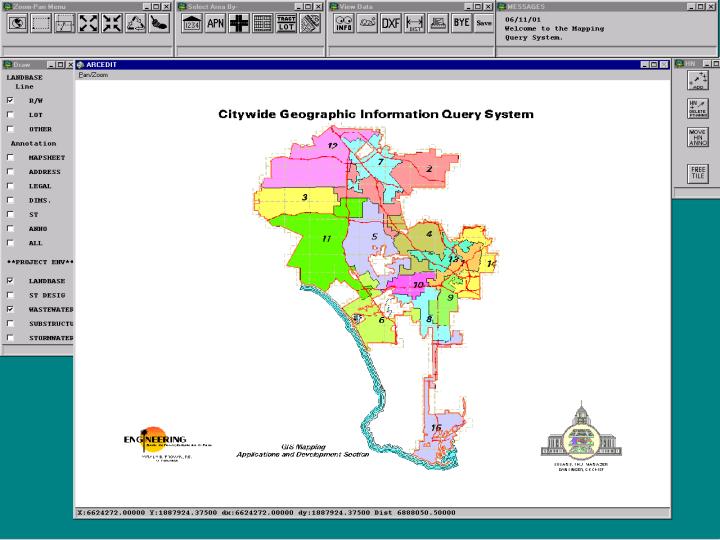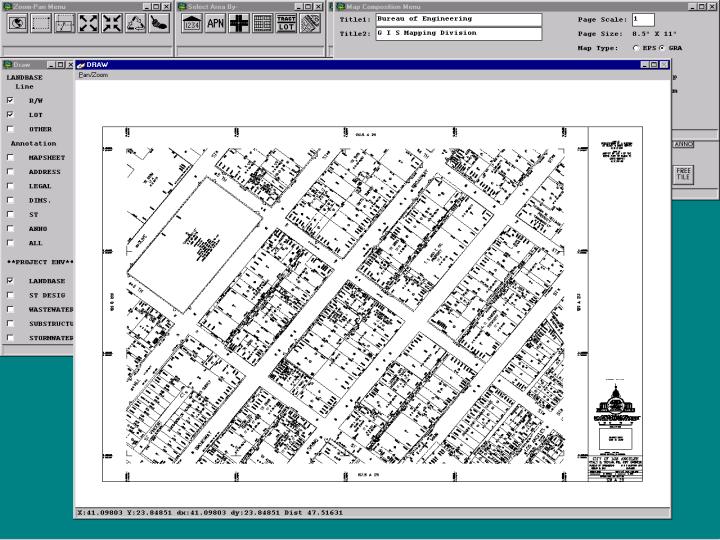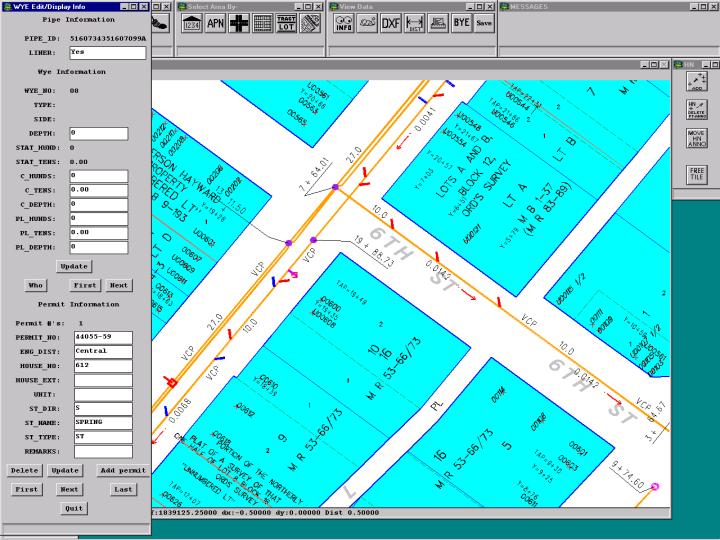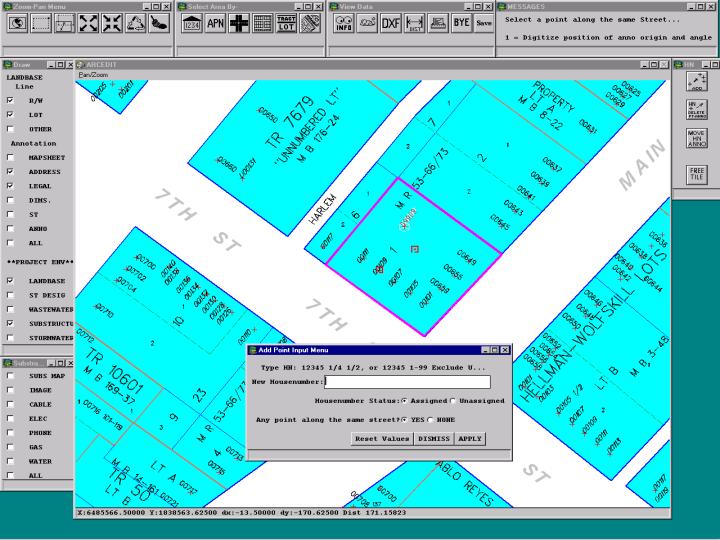
Introduction
The City of Los Angeles’ Bureau of Engineering has developed an ArcInfo application to perform query, edit, and plot maps using various data layers. The Bureau is responsible for the design and construction of various public infrastructures, including streets, sewers and storm drains. The Bureau of Engineering maintains GIS information for 470 square miles of land, 6,500 miles of streets and sewer system plus 1,700 miles of storm drain system. The Bureau also provides GIS support to various city departments and participate enterprise data sharing effort to facilitate e-government approach. This ArcInfo application has been named “Q-Query”, it was initially intended to provide query function, and then it was improved and expanded to provide most of the maintenance needs for the Bureau. The Q-Query application is a client-server based application and was originally written in ArcInfo UNIX version; with the recent release of ArcInfo 8, the Q-Query has been modified for PC NT user.
Background
The Bureau of Engineering started the conversion of cadastral maps from hard copy into electronic format in the late 70s’. A computer aided drafting (CAD) system called “Computer Vision” was used to store the cadastral maps information in electronic format. Due to the high cost of equipment, the city staff was put into three-shift operation to perform the conversion for the entire City’s land parcels. In the late 80s’, when the conversion effort was reaching its completion, and equipment replacement was desperately needed; the Bureau decided to migrate the electronic format from Computer Vision to GIS to better serve the Bureau’s long-term needs. Shortly after the decision was made, consultant was hired to digitize sewer maps and drainage maps into GIS format and the Bureau of Engineering took over the maintenance responsibilities after the completion.
Based on the old cadastral map index, the City’s GIS was divided into approximately 2,000 tiles; Esri’s ArcInfo and librarian management system were implemented and continue being used today to maintain the GIS data. Once all hard copy maps were converted into GIS format, the Q-Query application was quickly developed for the end users to access the latest GIS information by point and click. A map button for E-size hard copy maps was quickly added into the application to satisfy the request by end users. Soon after, Oracle database was implemented to provide data sharing and citywide enterprise needs, the Q-Query was expanded to sync the Oracle table and Info table maintenance. Recently, the Bureau promoted e-government approach, and the Q-Query was further expanded to allow the public counter staff to edit the coverage by point and click.
The Bureau’s GIS was established in UNIX environment; various issues kept the Bureau’s GIS remains in the UNIX environment, UNIX workstations are being used for most of the data maintenance effort. With the new release of ArcGIS, the powerful growth of web application, the needs of seamless database and the potential funding to replace all GIS workstations, the growth of Q-Query application need to be seriously evaluated.
ARCINFO Application – Q-Query

Figure 1: Q-Query user interface.
The Q-Query is written in AML, and needs ArcInfo license to function. This application presents a seamless data set to the end user, and synchronizes various maintenance needs behind the scene without any additional effort. sets Various datasets were used for The function can be described in detail as follows:
The basic user needs are organized using Graphic User Interface (GUI) to better serve the users; the user can point and click the GUI to perform pan, zoom, redraw, and return to default functions. The user can also point and click needed data layers to create customized view. Old hard copy maps are scanned, rectified and registered to provide as background information for the users upon request.
The query function is the initial intent of this application. Other than the land parcel, sewer system and stormwater system that are maintained by the Bureau, other tabular data sets, such as County Assessor’s database, are integrated together to present the overall query needs. You can query the entire city’s GIS database by type in address, street intersection, Assessor’s Parcel Number (APN), cadastral map index, and parcel unique identifier, etc. Once the query is submitted, the application will automatically zoom to the area. By choose the needed data layers from the screen, the users can customize their search.

Figure 2: Print Preview of a customized map
To provide hard copy maps to the customers upon request is one of the counter services provided to the public by the City. The Q-Query application includes a map button to produce various sizes of maps, from regular 8.5 by 11 to E-sized hard copies. The user can specify the map size and choose the needed data layers to create customized maps without knowing any AML commend.
The Bureau of Engineering is responsible for design and construction of various City’s capital improvement projects. The design engineers use either AutoCAD or Integraph workstations for their detail design work. To expedite the drafting process, the engineering drafting staff uses the Q-Query to zoom to the project area and export the needed data layers in DXF format to their CAD workstations for further editing. The Q-Query application presents a seamless data set for the user regardless the project location relates to tile boundaries.

Figure 3: Edit view - Edit Info table and Oracle database
To maintain the large database for a city like Los Angeles, how to minimize the error and improve data accuracy and consistency becomes a big challenge. The Q-Query application was developed to control the input and improve the accuracy. The application performs the coverage editing, the Info table revision and the Oracle database update at the same time to sync multiple database maintenance for enterprise-wide application development. For example, the official street name only typed once, and associated address assignments are using the street name from a pick list to avoid typo; and the unique identifier for a sewer maintenance hole is assigned by the system rather than operator’s manual input to ensure uniqueness. In addition, once the address is revised in the Info table, the address information in the Oracle table is simultaneously updated for other departments to use in their application development.

Figure 4: Edit view - Edit coverage, info table and Oracle database
The Bureau’s GIS contains approximately 2000 tiles, it is almost impossible for one person to maintain the integrity and consistency. The Q-Query application is being used to perform a series checking process to ensure completeness and consistency through out the GIS database.
Demo – ArcInfo 8.02 workstation for NT
Benefits
The Q-Query has been developed and used for many years and it has provided several benefit to the Bureau’s GIS needs:
Future Effort in Application Development
The GIS application development is towards:
Susan S. Shu, P.E.
Division Engineer/GIS Mapping Division
Bureau of
Engineering, City of Los Angeles
600 S. Spring
Street, Suite 300
Los Angeles, CA 90014
Phone: (213) 847-6360
Fax:
(213) 847-5242
Email: sshu@eng.lacity.org
Ricardo Najera
GIS
supervisor I/GIS Mapping Division
Bureau of Engineering, City
of Los Angeles
600 S. Spring Street, Suite
300
Los Angeles, CA 90014
Phone: (213) 847-5256
Fax: (213)
847-5242
Email: rnajera@eng.lacity.org